Built by Ed 'Big Daddy' Roth in 1959. Outlaw was the first car that Ed created using his special plaster and fiberglass method. Ed originally named the car "Excaliber" (after his mother-in-law's family Revolutionary War sword that was used as the shifter) but changed it be cause people had trouble pronouncing it. Ed sold "Little Jewel" to pay for the chrome work that was done on Outlaw.
331 cu. in. 1950 Cadillac V8 engine with four Stromberg two-barrel carburetors, 1939 Ford three-speed manual transmission, solid front axle with coil springs and custom-fabricated spring cups, live rear axle with single transverse leaf spring, and two-wheel hydraulic drum brakes at the rear. Wheelbase: 90"
When Ed Roth returned to California in 1955 after four years of service with the US Air Force, he purchased a 1930 Ford Model A Tudor that became his first show car, dubbed “Little Jewel”. Construction of the much more radical “Outlaw” T-bucket quickly followed in 1956, which set the stylistic direction of Roth’s future projects and greatly influenced hot rod design over the following decades. Built at a cost of just $800, the Outlaw was based on fabricated frame rails, a junkyard-sourced drivetrain, hand-molded fiberglass bodywork by Roth, a Larry Watson paint job and Cadillac V8 power by Fritz Voigt, Mickey Thompson’s chief mechanic. The extensive chrome plating on the Outlaw was financed by the sale of “Little Jewel”.
Believed to have been first shown at Disneyland in 1958, the Outlaw was originally called the “Excaliber” because of its shifter, a Revolutionary War sword that was used by an ancestor of Roth’s wife. The car appeared at over 100 car shows over five years during the late 1950s and early 1960s but despite growing success, Roth grew increasingly tired of the minutiae associated with car show competition, choosing instead to sell his wildly popular “weirdo” T-shirts and charging lucrative appearance fees at these events. With a well established name and image, Roth was now free to continue following his own creative muse, challenging the hot rod establishment with every mind-blowing custom creation that followed.
The enduring influence of Roth’s Outlaw remains profound, more than 50 years after it was created. In addition to massive public exposure on the show circuit, Revell produced hundreds of thousands of 1:25 scale model kits that were originally issued in 1962 and then re-issued in 2001. Roth’s pioneering plaster-cast fiberglass body construction techniques were also outlined by Griff Borgeson in his 1958 Fawcett how-to book on hot rods, while cover stories in Car Craft and Rodding & Restyling ensured the Outlaw’s lasting fame among generations of custom car enthusiasts. In 1970, Roth sold the original Outlaw to Jim Brucker, with the car passing to Bill Harrah and then to the Petersen Automotive Museum, where it currently resides. |

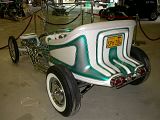

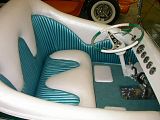
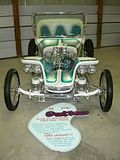
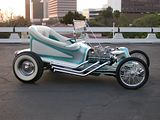

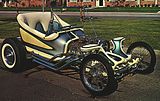
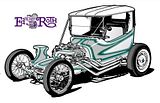
|












